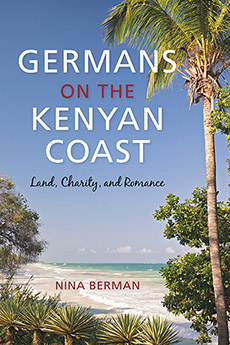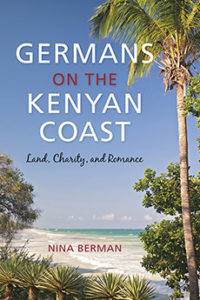
 Nina Berman’s Germans on the Kenyan Coast: Land, Charity, and Romance is a thoughtful effort to draw connections between the ever-vexed land question in the postcolonial world, the frequently oversimplified complexity of the history behind this, and the often-marginalized ways in which the personal has played as important a role as the political in externally-driven material development in Africa. As such, it is a welcome addition to an otherwise limited writing of its type.
Nina Berman’s Germans on the Kenyan Coast: Land, Charity, and Romance is a thoughtful effort to draw connections between the ever-vexed land question in the postcolonial world, the frequently oversimplified complexity of the history behind this, and the often-marginalized ways in which the personal has played as important a role as the political in externally-driven material development in Africa. As such, it is a welcome addition to an otherwise limited writing of its type.
It is a book that resonates for me personally in a number of ways as well. I am delightedly married to a German, I have spent nearly thirty years of my life involved with one project or another in Africa, and I have also visited the Diani coast, which serves as the principal site of Berman’s investigations about her chosen aspects of Kenya’s interactions with a wider world.
The first time I went to Diani, I spent a few days beforehand in old Mombasa. My fieldwork for the past eighteen years has kept me in the villages around Kibwezi, about 200 miles inland from the Indian Ocean coast in one of Kenya’s “hardship” areas of low agro-ecological potential. In July, only half-grown maize stands bleached white in the cracked red soil baking beneath the tropical Sun, skeletal reminders that Makueni District really isn’t the ideal location for cash cropping, at least not by Akamba smallholders without the capital to invest in significant irrigation, let alone title deeds to the land on which they are squatting. Five of us, all wazungu (generically, white people, though two Japanese were among our number), needed a break and had the means to take one, so together with a Kamba friend we hopped aboard a train moving at barely more than a jogging pace and went down to the sea. Without a plan, we checked in at a hotel that was a slightly dilapidated reminder of past colonial-era elegance actually beyond our budget, and for a couple of nights I was grateful for clean sheets and a proper bed, the familiarity of a fully functioning toilet and a helpful if wobbly ceiling fan.
But my first impression of the place was of the single sheet of paper positioned carefully on the pillow of each bed, typed (not printed from a computer) in Italian on one side and German on the other, offering both girls and boys of various ages and physical conditions for sexual rental, prices at hourly or daily rates. My second impression was of the prostitutes in the streets outside the hotel, many if not most wabara – “upcountry” women from interior parts of the country– but almost invariably covered head to toe in a shapeless black Muslim buibui. To a Westerner, this may at first seem a counterintuitive manner of presentation inasmuch as the body on offer can’t be seen, yet there is the practical advantage of avoiding arrest when the authorities are loathe to risk offending genuinely modest women in a largely Muslim city. Likewise, the buibui offers foreign eyes even more of something it has come to Africa to look at, an Other made even more exotic by attire than by skin color, not least of all given the likelihood that a prostitute’s precise geographical origin is of little concern to her customer.
Soon short on funds, our group packed up one morning and went down to the beach. Still without a plan, we hiked south along the shore without a destination in mind. Eventually, hunger and a lengthening afternoon made us pay attention to our surroundings, and by chance we stumbled upon a small huddle of cottages in various stages of unprofessional renovation. They were owned by a half-Kenyan Goanese; that is, a little old man of part-Indian, part-Portuguese, part-African heritage, one of that peculiar population whose roots in the country predated European arrival but who were subjected to increasing racial hostility throughout the colonial period. In July of 2017, this complex identity and difficult history arguably was made even more, not less problematic, when Kenya’s current dictator officially elided every subtle difference by “recognizing” the “Asian” population as the country’s 44th tribe. But of that afternoon all those years ago, I just remember aching feet and gratitude for the unasked-for gift of sweet tea. We rented one of the cottages for a few days, pooled our remaining shillings to buy food from a local market and so enjoyed our happenstance vacation that we kept our good humor even when a gang of colobus monkeys swopped down from the roof one morning and stole our breakfasts before we could react. I also remember our Kamba friend, one of the very first people in Makueni District to raise public awareness about the AIDS epidemic (for which his home and his person were assaulted many, many times), wading in the shallows off Diani beach surrounded by a circle of young prostitutes and drug dealers, calmly giving an impromptu seminar about HIV prevention.
There is much in this vignette that connects to Berman’s work, especially in terms of the varied relationships of wabara, wazungu, and wenyeji (roughly, those indigenous to a place). The first and smallest third of Germans on the Kenyan Coast sketches what is appropriately understood to be the longue durée effects of colonialism on today’s land issues in the Diani region. Personally, this is the section that most attracted me, but that’s because there are so many familiar moments in Berman’s tales that echo my own experience upcountry. For a long time, for instance, the Digo and other wenyeji of the coast have been victims of land alienation or, alternately, have sold their lands in anticipation of losing recognizable ownership before they could profit from doing so. Likewise, in the area I know well around Kibwezi, less than 10 percent of the people working the land own title to it, and similar land-grabbing by nonlocals has occurred on a massive scale. Berman carefully reconstructs some of the history of hotel and golf course development in the Diani area, while I have spent years listening to stories of painful eviction by Kenya’s colonial and postcolonial governments in order to create so-called ‘wilderness’ areas for expansion of safari park landscapes. Indeed, the World Travel & Tourism Council claims that these sorts of development contribute about 10 percent to Kenya’s GDP already, with annual growth over the next decade predicted at around 6 percent. Berman reminds her readers that Germans such as zoologist and conservationist Bernhard Grzimek (one of my wife’s childhood TV stars) played a significant role in the rise of a tourism paradigm based in equal measure on spectacle and distortion of the facts on the ground in East Africa as elsewhere.
Likewise, within the wider region of Berman’s coast, one of the largest of the mostly-failed colonial cash-crop efforts is the REA Vipingo sisal estate, now rapidly being converted into a multi-billion-shilling development of luxury homes being bought up by wealthy foreigners and the Kenyan political elite. Coincidentally, REA Vipingo also owns the Dwa Estate in Kibwezi, where many people dear to me have watched their ancestral lands, graves, mathembo shrines, and more be plowed under for a sisal crop now being planned for use as a biofuel. At the coast, too, construction of expensive homes is applauded for being connected to wind and solar utility projects meant to power them. Berman has little to say directly about how global discourses of sustainability are underwritten by large-scale development-induced displacement, but though I might wish she’d done more here, it’s clear she has a different agenda, not that she’s unaware of the issues.
Indeed, her effort is focused on humanizing many aspects of such larger issues, showing in the book’s third main chapter how large changes on the landscape both impact and are impacted by very personal stories. Often these are stories of unplanned encounter initially, and even when the African-and-European couples she describes later in the book marry, have children, and otherwise establish more substantial, deliberate connections, Berman carefully emphasizes how often it is risky to assume a fixed trajectory of what happens next in such lives. I’ve encountered similar stories. A German businessman left one family in South America and another in Europe before ending up running a hotel of sorts in Kibwezi with a local Kamba wife, eventually converting to Islam while trying but failing to fit into the town’s minority Muslim community. His hotel fell into disrepair when it was abandoned by his African family after his death. Or again, an American woman (a former student of mine, as it happens) fell in love with a local man in Kibwezi, married and had children with him. She invested heavily in building a house for their family, as well as in her mother-in-law’s business and in a large project intended to reestablish a severely denuded forest nearby. Today, she has returned to the United States with her children, her husband embezzled the money intended for the tree-planting project and spent some time in prison for other crimes, and her mother-in-law has quit Kibwezi to return to her home elsewhere in Kenya. To be sure, not every story of transnational relationship has to end badly, and Berman provides a fascinating window on what it takes to determine what counts as success or failure in each case.
In between chapters about land and romance, Berman develops an important related theme of a “pervasive culture of charity” in Diani. She emphasizes a distinction between “professional” and “contraband” humanitarianism, suggesting that inasmuch as the latter is carried out by individuals without involvement of Kenyan government officials, it can be more efficient in achieving its goals given a minimum of bureaucracy and overhead costs. But at the same time Berman is critical of contraband humanitarianism because she thinks it fosters dependence more than reciprocity. While I don’t dispute that charitable efforts externally defined and supplied can prove disastrous, I’m not entirely convinced by Berman’s arguments here, at least not in the implication that involvement of governmental institutions is preferable. In the villages around Kibwezi, I have seen schools built and teachers paid by foreigners, for example, where the government of Kenya subsequently has intruded in any number of ways which, even when arguably well-intentioned, have demotivated teachers, students, and parents significantly. Berman’s point here is worthy of serious consideration; namely, that contraband humanitarianism disables growth of expectations of governmental accountability and transparency in countries where they are rare. But this certainly doesn’t imply that the opposite is automatically true (i.e., that working with government enables a culture where institutions fairly and responsibly represent people).
I’m sure Berman is aware of this – and I absolutely agree that too much externally-driven ‘help’ is absurdly redundant, even useless (building schools in areas where they are not needed, for example, or as I’ve seen too often around Kibwezi, irrigation and water storage projects that are too expensive for locals to repair once they inevitably break down) – but in between these polar opposites she is not especially helpful in showing us a practical middle ground. Instead, at least as regards Diani, Berman is quick to declare traditional forms of social organization such as utsi and mweria as “more or less extinct.” Certainly, those spending time upcountry in the Kibwezi area might reach the same conclusion, but on closer examination it’s possible to discover, for example, that the Kamba culture of mapping out mathembo shrines on the landscape still exists and therefore might be reinvigorated to enable new social movements around traditional rights to wood and water resources. In the villages around Kibwezi, I’ve also encountered the persistence of ngolano women’s groups that have powerfully intervened despite the material poverty of their members to deflect and even halt development projects considered injurious to local communities. Help from outside that tries to meet people where they are is what is needed, and much more space than is possible for this review is necessary to discuss the deficiencies of an assumption that ‘traditional’ culture is static and hidebound when in reality it is dynamic in adaptation to changing circumstances. Empowering the old in new ways is a vital part of overcoming both the inefficiencies of the African state and the infantilizing effects of neocolonial humanitarianism from abroad.
Especially in times of economic decline following terrorist attacks and international irresponsibility that systemically sparked them, I agree with Berman’s observation that pity (Mitleidseffekt) is today the clear “winner” on the Kenyan coast, as elsewhere in the country. But in the final moments of Germans on the Kenyan Coast, Berman also acknowledges that diverse motivations account for a lack of unified action amongst the various peoples of the Diani area. Faced by challenges of all sorts, an appeal to “common sense” misses the point, Berman reminding us of Gramsci’s insight that “one can find there anything that one likes.” What appears to be common is actually often more intimate instead, and therefore less likely to serve as the basis for collective action. The agonizing reality is that at least since the Mackinnon Road started pushing into the interior towards Kibwezi in 1890, the coast has been repurposed many times in many different ways to serve as part of a fiction called ‘Kenya.’ That was true when British Kenya centered itself on a railway encampment that grew to become the modern sprawl of Nairobi, and it is even more the case today. In the sadly predictable melodrama of 2017’s electoral campaign, the Kenyan center of the ruling Jubilee Party alternately threatened coastal governors with arrest while likewise rushing to issue hundreds of thousands of title deeds to land-hungry locals. In the election’s aftermath, too, the official NASA opposition to Jubilee’s continued stranglehold on power planned to use the Coast region as the first part of the country to organize a parallel government, even though all the NASA leaders come from the Kenyan interior (indeed, most of its’ principals hail from the far west of the country). Berman’s book does not intend to address this question of the center-versus-the-margin directly, but it does provide lots to think about it. She ends by questioning if the possibility of “distributive justice” really can be effected at a global level and tends to believe that much of the fight over issues about control of land and resources is already lost, though she nonetheless leaves at least some room to be hopeful about the possibilities of reinvigorated, and indeed refashioned, forms of community and solidarity.
Reviewed by Mark Lawrence, Bemidji State University
Germans on the Kenyan Coast: Land, Charity, and Romance
By Nina Berman
Publisher: Indiana University Press.
Hardcover / 289 pages / 2017
ISBN: 978-0-253-02430-5
Published on March 1, 2018.




